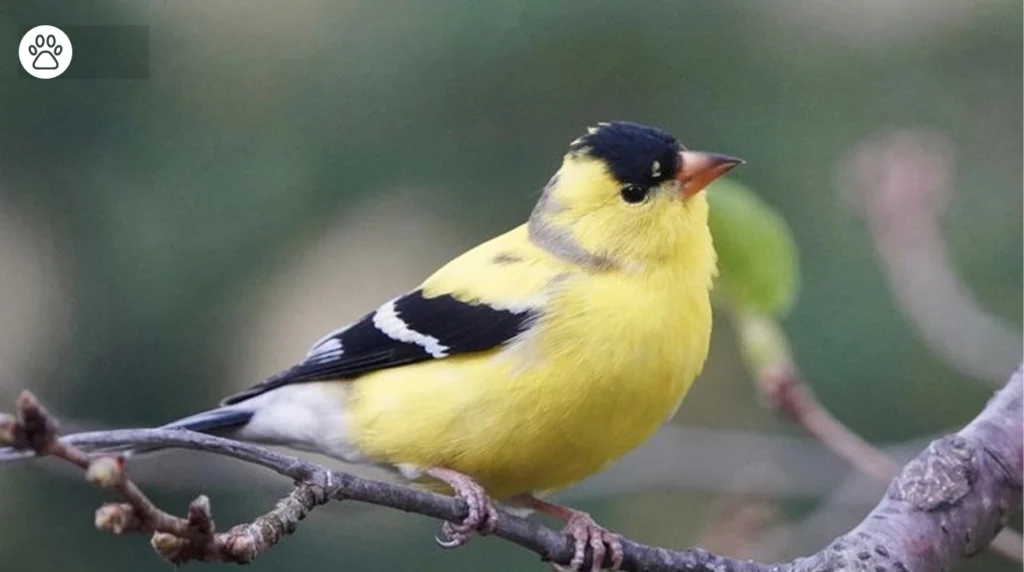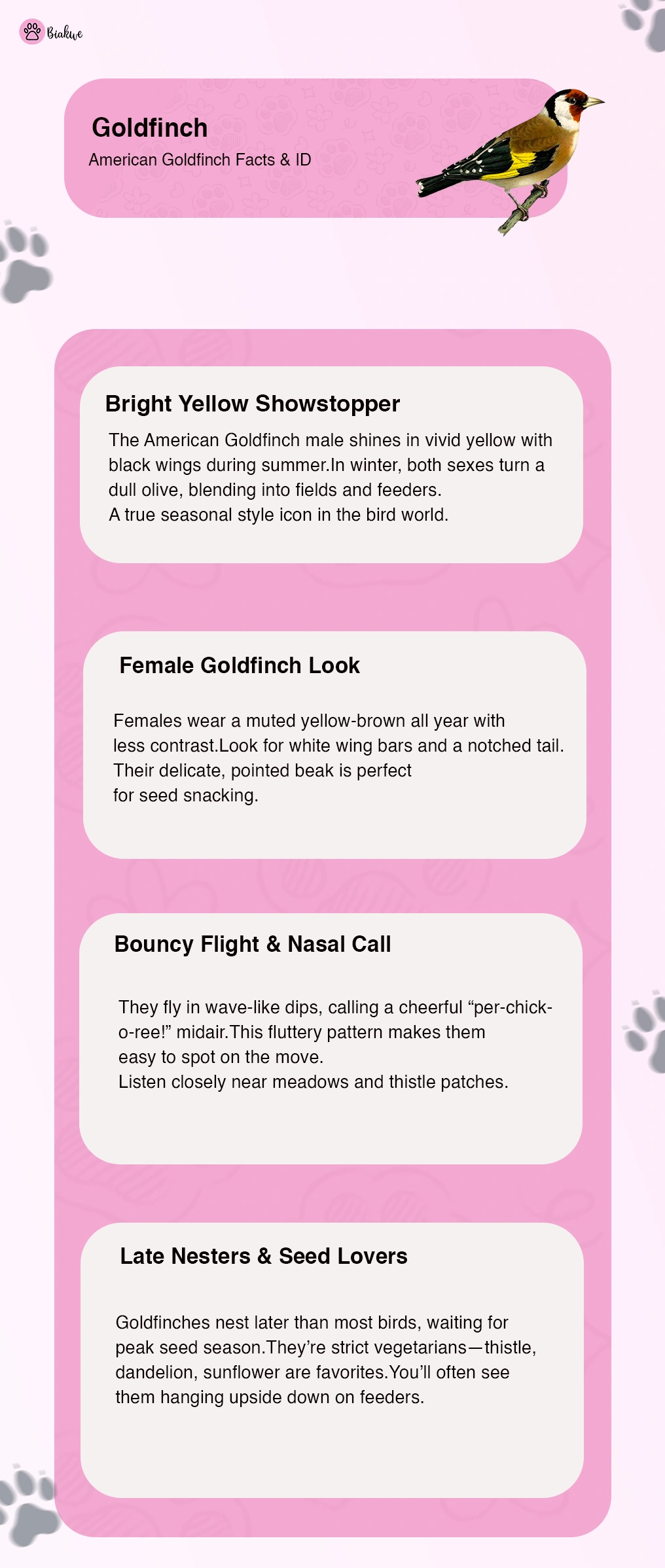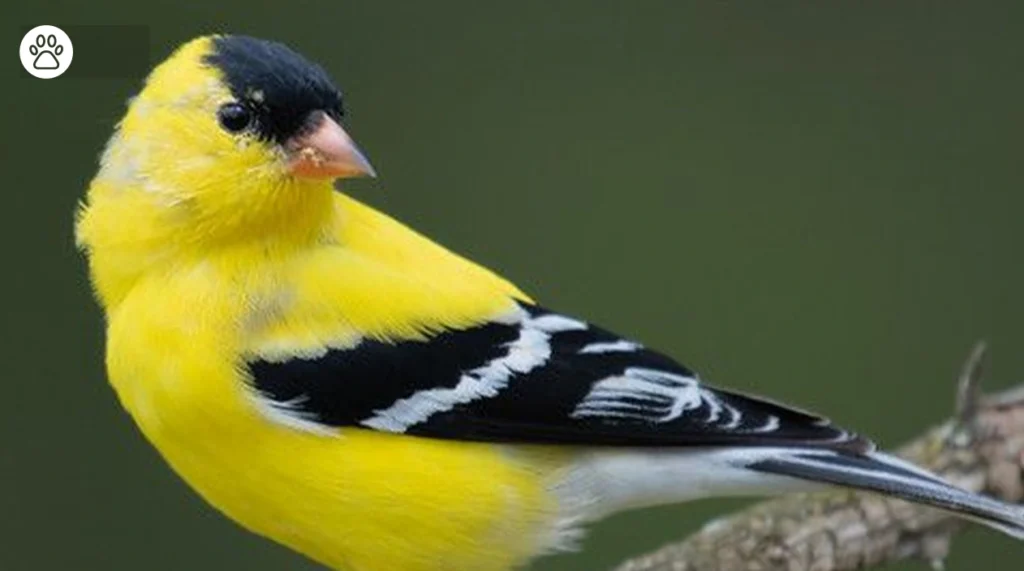Originally, the goldfinch was a North American bird from the finch family. Now, after migration, you can find this gold bird everywhere, including Alberta, North Carolina, Canada, and from the United States to Mexico. Therefore, it is famous by the name ‘American Goldfinch’. This black and yellow bird is a symbol of love and adaptation.
Now, let’s take a closer look at Carduelis tristis, the American Goldfinch bird. This unique species stands out with its cheerful sound and multiple colors. The yellow finch leaves a wonderful impression by flying and feeding with flips and flips. The eastern goldfinch, or American goldfinch bird, is a beloved visitor to yards throughout the continent.
Many people who like birds are unsure about which species a black and yellow bird might be when they see it at their feeders. Many goldfinch species exist, but learning about the American goldfinch will help you tell them apart and enjoy its special characteristics.
How to Identify a Male American Goldfinch
In spring and summer, male American goldfinch birds show impressive breeding feathers. Both adults and juveniles have a striking canary yellow color. Black caps are their unique headgear. They are recognized by their big white wing bars on black wings. It contrasts so properly that it looks striking as a black and yellow bird. The males vary in length from 4.3 to 5.1 inches. Adult wingspans are 7.5 to 8.7 inches long when stretched out.

How to Identify a Female American Goldfinch
The year-round colors on female goldfinches are duller than they are for male goldfinches. They have olive brown to dull yellow on the stomach, legs, and belly. Wings show as a dark brown color with white spots. Unlike males, females do not have a stunning black cap.
Discover: Oscar Fish Care: Tank Size, Mates and Lifespan Tips
Nesting and Breeding
Compared to most songbirds, the American goldfinch delays making its nest. Female goldfinch birds make a cup nest. They work with plant fibers, spider silk, and caterpillar cocoons when making nests. The construction process usually finishes in 6 to10 days. The female does all her work by herself, while the male protects the hunting area. A nests measures around 3 inches across when it is finished.
They have newborns during July and August. At that time, numerous sources of seeds became available. Late nesting is beneficial to birds.
- It’s a time of the highest thistle seed numbers
- Cowbird parasites are few.
- Chicks need warm temperatures.
- There is a plentiful supply of protein from insects.
American goldfinch females typically lay 4-6 pale blue eggs. After mating, eggs remain in the nest for about 12 to 14 days. Only the females in this species are responsible for hatching the eggs. It takes 11 to 15 days for chicks to leave their nest after hatching. Parents give them food that comes from seeds they have regurgitated. Young birds require insects as a source of protein.
Seasonal Plumage Changes
American goldfinch birds go through remarkable changes throughout the year. In the fall and winter, males’ bright yellow color fades. They grow feathers that are olive-brown, like the females’ have.
Birds go through molting twice each year. Spring returns the rich colors used by birds in the breeding season. The winter colors help birds hide better when it is especially cold.

American Goldfinches: A Look into Their Plumage
It’s pretty easy to identify an American Goldfinch once you learn what to look for in these pretty songbirds.
Explore: Best Cat Food Brands for Indoor Cats in 2025
Male American Goldfinch
A stunning show in summer – Starting around late spring and continuing to late summer, the male American Goldfinch is so bright and distinctive that he stands out right away. His body is bright lemon yellow, there’s a sharp black cap on his head, and he has black wings with white stripes. The tail is black, with shades of white on the undercovers. To get a potential partner, this fantastic display plays an important role.
A Delicate Beauty – The Female American Goldfinch
Though the male American Goldfinch is bold and colorful throughout the year, the female has a more relaxed color scheme and stays plain during breeding season. Her skin is usually dull yellow or sometimes brown with olive shades. Her wing feathers are usually dark or black and include two light-colored bars. She isn’t identified by a black cap, which the male bird has. With camouflage, the mother bird can easily hide when laying her eggs.
American Goldfinch in Winter Appearance
Interestingly, the American Goldfinch changes its plumage with the changing seasons. Both males and females will shed all their bright summer feathers in winter. Grown-up males generally turn a drab yellow or brownish-olive and still keep a small area of yellow in their markings. You may notice that the strips you see in white are not as clear as before. After reaching adulthood, females become plain brownish-gray. Even so, it’s harder to spot them in winter, though their shape, flight, and size are still helpful.
The Juvenile American Goldfinch
American Goldfinches, when they are young, have brownish-olive feathers, just as female adults. They can appear as if they have a wash of yellow, and usually, their wing bars are a warm buff color instead of a stark white.

Are Yellow Finches and Goldfinches the Same?
Many people ask this. A lot of people ask what sets yellow finches apart from goldfinches. If you hear the words yellow finch in North America, it is nearly always the American Goldfinch they are talking about. For most people, these terms are used synonymously. You’ll likely see American Goldfinches if you look for yellow finches in eastern North America.
That said, yellow occurs in other birds besides finches and canaries, or warblers that have become free in the wild may also be referred to as “yellow finches.” When we talk about American wild birds, it is usually the American Goldfinch that is the top yellow finch.
Separating the American Goldfinch from other yellow birds
Even though the American Goldfinch is easy to tell apart, there are a few black and yellow birds that could be confused with it, though not for very long.
- Lesser Goldfinches stand out with a smaller size and an olive-green back color on most, although some males show black instead. A black band along the head goes further down the male’s head than the female’s.
- Pine Siskins are another kind of finch, and unlike American Goldfinches, their coloring is streaky brown and yellow. Often, their wings and tail look like they have been wrapped in yellow.
- Evening Grosbeak males are much larger than other finches, and they display bright yellow feathers, a hooked beak, white patches, and black wings. Its distinct features are its big body and giant beak.
- Yellow warblers differ from finches because they are smaller, thinner, and do not have the thick finch beak. Seattle and Vancouver sometimes hunt for food differently.
Learn More about Fishes here: Freshwater fish
Final Words
Call them eastern goldfinch, American goldfinch, or just goldfinch; these birds naturally get our attention and need conservation. Owing to their presence, birds show that an environment is healthy and give great pleasure to many bird watchers. Watching colorful birds can make your time in any natural area more enjoyable.
Their sweet singing and cute actions help us see and appreciate the natural world. Remember to set up the proper environment and offer the right food if you wish to see or attract these lovely birds. By taking care of nature, there’s a chance you’ll keep spotting an American goldfinch resting in your yard.
Visit biakwe.com to learn everything about birds.
